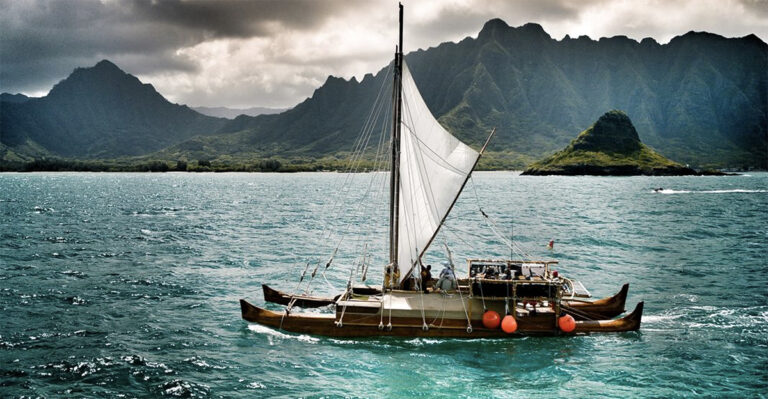[Reprinted from the Center’s September 2007 newsletter]

By Mikaele Foley
LAIE, Hawaii, June 2024 — The Polynesian Cultural Center and Brigham Young University–Hawaii, which have worked together for 60-plus years to support the education of thousands of students, agreed about a year ago to expand their unique partnership even further to work more closely with BYU–Hawaii’s majestic 57-foot wa’a kaulua — a traditional twin-hulled Hawaiian voyaging canoe, beginning with preparing it to join 26 other entrants that month in the 2024 gathering of canoes during the 13th Festival of Pacific Arts and Culture.
Festival of Pacific Arts and Culture gathering of canoes: FestPAC is a quadrennial two-week cultural celebration of indigenous peoples designed “to halt the erosion of traditional practices through ongoing cultural exchange.” It started in 1972 in Suva, Fiji, and rotates locations, but only met in Hawaii this year for the first time — providing an excellent opportunity for the Iosepa to participate.
FestPAC canoe gathering’s can trace their history to when the Honolulu-based Polynesian Voyaging Society built its 62-foot double-hulled, twin-masted Hōkūle‘a canoe and attracted worldwide attention when its crewmembers sailed round-trip to Tahiti in 1976 using only traditional non-instrument wayfinding.
Thousands of Tahitians awaited the Hōkūle‘a arrival in Papeete, and the number of similar Pacific voyaging canoes patterned after those used centuries ago to migrate across open oceans began to increase and soon became a feature at subsequent FestPAC gatherings.
The voyaging canoe renaissance blossoms: Of course, the Polynesian Voyaging Society Hawaiians (and others who have created such crafts since) first had to reacquire ancient wayfinding knowledge, which hadn’t been used for centuries in most of the islands.
Hōkūle‘a navigators, for example, worked closely with the late Pius “Papa Mau” Piailug, a master navigator from remote Satawal atoll in the Eastern Caroline Islands of Micronesia. There, he and a small number of others grew up learning to sail far out to sea by memorizing the movements of the sun and stars, cloud formations, changes in wind directions as well as ocean currents, and other natural navigational indicators.
Naturally nowadays, modern versions of these canoes and their crewmembers also use electronic navigational devices powered by solar panels, cooking stoves, ice chests, etc., and they’re also usually accompanied by motorized escort vessels that can tow the canoes in and out of harbors and anchorages, or whenever else needed.
BYU–Hawaii creates the Iosepa in 2001: When the BYUH Hawaiian Studies program started in 1998, its initial faculty and students also dreamed of creating their own sailing canoe, and with the help of special grants and donations, this started to become a reality in 2000.
With permissions and plans in place, the late William “Uncle Bill” Kaua‘iwiulaokalani Wallace, the first BYUH Hawaiian Studies director, approached Tongan master carver Tui’one Pulotu, and Hawaiian master carver Kawika Eskaran. Both singed on.
Pulotu, a former labor missionary who settled in Laie after helping expand the university campus and build the Center, had just finished creating a 105-foot kalia-style canoe [where one hull is usually smaller and acts like an outrigger] in Tonga for the 2000 millenium, and Eskaran later joined the project as soon as he was available.
